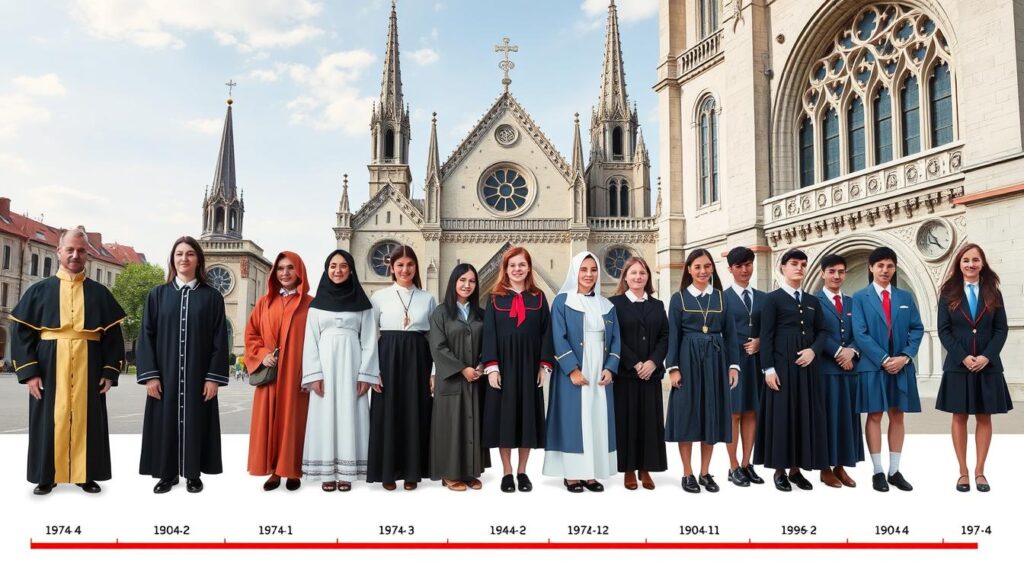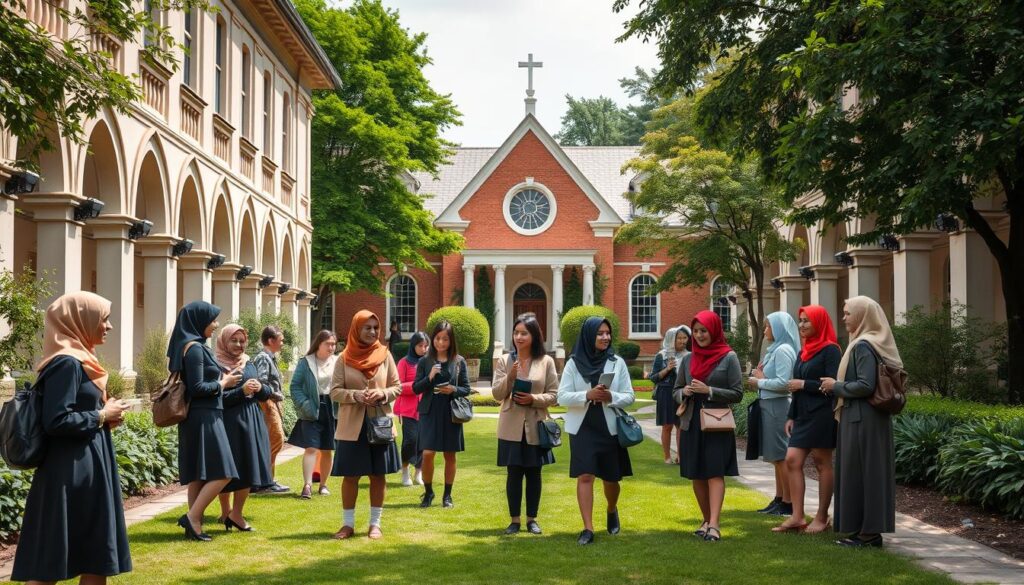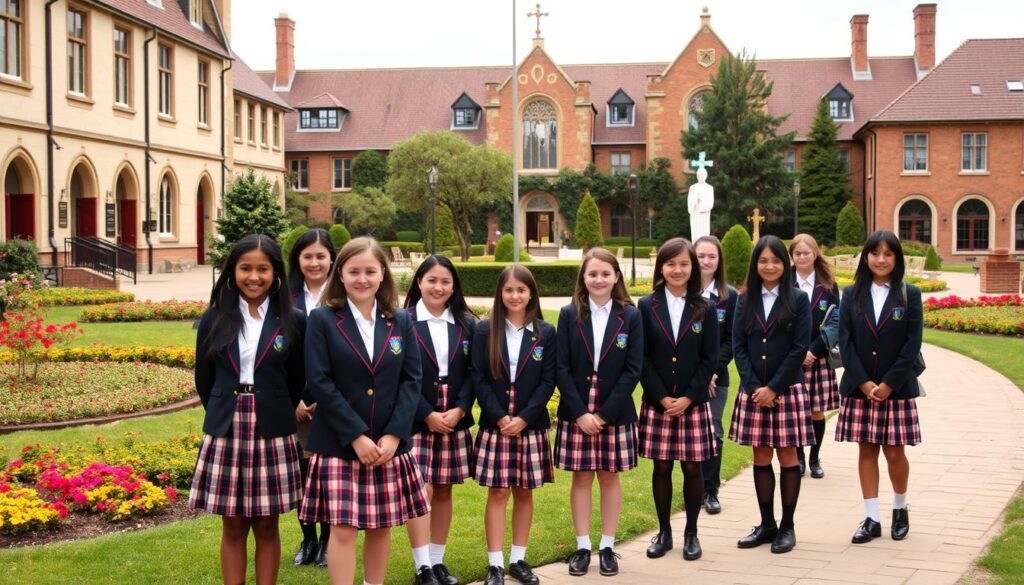Catholic school uniforms stand for more than just discipline and unity. For over a hundred years, they’ve shown the values and identity of Catholic education in the US. People often wonder what the modern uniform policies at Catholic colleges are like.
Uniforms are a must from Kindergarten through 8th grade, leading to a 100% uniform or dress code policy adherence. Take the grey blazer with the college badge, for example. It symbolizes college pride and must be worn always. School shoe choices are also about safety, banning casual and unsafe options like sneakers or jeans. Yet, a variety of sock colors offers some freedom.
The rules can bend a little, allowing for non-uniform days decided by schools. On these days, shorts have to be at least mid-thigh long. Some casual trends are off-limits. This mix of strict and flexible rules helps everyone feel like they belong while keeping the school’s standards high.
Student Council talks let students play a big part in discussing uniform changes. This shows they are valued. Everything, from the PE kit to the rules about jewelry and needing durable, waterproof bags, shows how important it is to look and be prepared as part of a respected community.
Key Takeaways
- Uniforms in Catholic colleges are an embodiment of educational values and communal identity, not just a religious symbol.
- 100% of students must adhere to the uniform policy, with guidelines extending from K-8 and including full participation in PE kit requirements.
- Safety and neatness are central to uniform policies, influencing shoe choices and prohibiting casual, potentially hazardous clothing.
- Special non-uniform days are permitted, with specific dress codes to maintain institutional decorum.
- Student voice plays a role in uniform policy development, emphasizing student agency within the community.
- Details such as acceptable jewelry, makeup, and bag requirements affirm the college’s stance on professionalism and preparedness.
- Disciplinary action is taken for any violations of uniform, dress code, and appearance regulations, underscoring the importance of conformity and pride in presentation.
The Evolution of Catholic Attire Across History
The story of Catholic school attire and Catholic clothing’s development is fascinating. It shows how culture and beliefs shape each other. This change reflects society’s shifts and the deep bond between religion and style.
An Overview of Catholic Clothing Changes
Early missionaries wore loose robes, while today’s Catholic students wear structured uniforms. The 19th and 20th centuries saw big changes. The book “Common Threads” covers this era well. Catholic clothes in the US changed due to local styles and the needs of different church orders.
For religious women, the change was huge. Their habits changed a lot, based on what fabrics were available and their activities. The changes went beyond practicality. They started to show the wearers’ community roles more clearly. This showed their commitment to leadership, humility, and serving others.
The symbolism in Catholic school clothing became very important in schools. It stood for values like discipline and unity. This made these uniforms more than just clothes.
Understanding the Symbolism Behind Catholic Attire
Catholic school clothes are full of symbolism. At first, they showed a commitment to a spiritual life, not worldly fashion. As Catholic schools grew, uniforms helped create a strong community identity. They stood for shared values of respect and morality.
Uniform designs changed over time. For example, the early 20th century had middy blouses and jumpers. By the mid-1960s, plaid skirts and blazers were in. These designs aimed for modesty and practicality. They also helped hide economic differences among students. This showed the Catholic belief in equality in education.

The story of Catholic clothing and its symbolism is about adapting culture, where clothes link to community values and history. These garments tell a tale of societal shifts, faith’s lasting impact, and how tradition and modernity mix in Catholic life.
Do Catholic Colleges Have Uniforms: Contemporary Practices
When we ask, “do Catholic colleges have uniforms?”, we see diverse practices. Catholic colleges use uniform policies to foster respect and reflect their values. These policies range from strict dress codes to relaxed attire rules.

Catholic colleges value a standardized look to boost community spirit. They believe it keeps the focus on learning instead of clothes. Uniforms also show the school’s identity, especially during religious events.
At some Catholic universities, strict dress code guidelines are in place. Meanwhile, other schools might only require formal wear for special occasions. This shows how Catholic colleges adapt to modern needs while holding on to their traditions.
- Strict Uniform Policies: Some schools demand formal clothing, like robes or standardized suits.
- Relaxed Guidelines: Other colleges ask for professional attire in class but allow casual clothes elsewhere.
This flexible policy helps Catholic colleges balance uniformity and self-expression. It aims to unify students, keep them focused on studies, and maintain a respectful atmosphere. This upholds the college’s dedication to its Catholic roots while navigating modern educational demands.
Defining the Catholic School Uniform: A Closer Look

Catholic school uniforms blend tradition with the values of Catholic schools. They have always been more than just clothes for conformity. They symbolize shared values and identity.
The Distinctive Characteristics of Faith-Based School Uniforms
Catholic uniforms promote modesty and neatness. For instance, the navy blue jumper from the 1950s with a white blouse is a classic. These uniforms create unity and honor Catholic traditions.
Materials and Styles: The Components of a Catholic School Uniform
| Decade | Common Styles | Materials Used |
|---|---|---|
| Early 20th Century | Military-style for boys, simple dresses for girls | Woollen fabrics, linens |
| 1940s-1950s | Plaid A-line jumpers, navy blazers | Cotton twill, corduroy |
| Modern Day | Permanent press, wrinkle-free uniforms | Polyester and synthetic blends |
Today’s Catholic school uniforms mix visual standards with practical needs. They use durable polyester blends. This means the uniforms are both easy to care for and long-lasting.
Modern fabric technology improves uniforms, making them functional and value-driven. As schools change, so do the uniforms. They remain a key part of Catholic education, symbolizing unity and respect for tradition.
Uniform Policy in Catholic Colleges and Its Importance
The uniform policy in Catholic colleges is more than a dress system. It’s key in teaching discipline, unity, and equality. It gives students a sense of belonging. Catholic college dress code policies also aim to create a good setting for learning and moral growth.

Historically, the catholic school uniform policy comes from old European customs of uniformity and following rules. This was brought to American Catholic schools by European immigrants. Now, these dress code requirements at catholic colleges help level the social playing field. They also support a simple, orderly way of life for students.
How Uniform Policies Shape Discipline and Identity
Uniforms are key in building discipline and identity in students. Wearing a certain outfit every day reinforces the school’s values. It fosters unity and respect. This uniformity cuts down distractions, helping students focus on learning and growing.
The Role of Uniforms in the Educational Environment
In schools, uniforms create an equal setting. It’s where students see each other for their actions and character, not clothes. The strictness of a uniform policy also readies students for future careers that might have dress codes.
| Year | Status of Uniform Policy | Impact on School Enrollment |
|---|---|---|
| 1963 | Introduction phase in America | Increased debate and interest |
| 1970s-Present | Uniforms common in Lower Grades | Stable to increased enrollment, especially among Latino communities |
| Future Outlook | Expansion to remaining schools | Potential for higher uniformity and inclusivity |
As the catholic school uniform policy evolves, it continues to play a key role. It helps keep discipline and promote equality. Catholic colleges in the U.S. show the importance of these policies. They work towards a better academic and moral environment.
The Impact of Historical Precedents on Modern Catholic Uniforms
The link between traditional attire at Catholic schools and history is strong. It shows how old trends shape our current uniform rules. By looking back, we see why dress code at Catholic educational institutions is the way it is today.

From Practicality to Symbolism: A Journey Through Time
Uniforms started out simple and sturdy. They were made to last through daily use. Over time, Catholic schools began to mix in spiritual meanings with practicality. This change brought uniforms that stood for unity and faith, as much as for daily wear.
Adaptations and Variations in Catholic Clothing Over Centuries
Over time, catholic school uniform culture has evolved. In the early 1900s, uniforms changed to suit physical activities while keeping modest. Today, we see different styles and colors that reflect each school’s tradition and location.
This careful modernizing of uniforms keeps Catholic education’s cherished traditions alive. At the same time, it nods to modern society and student needs. Thus, the uniforms tell a story of faith, tradition, and community that evolves with time.
Catholic School Dress Codes and Their Enforcement
The rule of dress codes in catholic schools is vital for keeping standards high. It makes sure students look alike, showing modesty and professionalism. These rules help create a place good for learning and respect.
Setting Standards: The Details of Dress Guidelines
Catholic school dress rules cover many details, from skirt lengths to shoe types. Lake Catholic High School, for example, has clear rules on khaki pants, skirts, and polo shirts. These rules mean every student dresses equally, making things fair and uniform.
Personal experiences show how dress codes affect students. For example, skirts must be knee-length to keep the environment respectful. There are serious cases, like a student missing graduation over wrong shoes, showing how strictly rules are followed.
Navigating Non-Uniform Days: Expectations and Regulations
Even on casual dress days, catholic schools keep strict rules. Students can choose their outfit, but it must be modest and appropriate. No torn, revealing, or offensive clothes are allowed. This keeps the school orderly, even without uniforms.
Take Lake Catholic High School’s policy for mass days, for instance. Students pick formal clothes, different from their everyday uniform. This rule keeps students looking proper for any event, teaching them about respect and presentation.

Catholic schools’ uniform policies are about more than just clothes. They teach values that last beyond school years. By enforcing these dress codes, schools help students grow educationally and personally.
The Cultural Significance of Attire in Catholic Educational Institutions
The attire at Catholic educational institutions is more than a dress code. It shapes the educational journey. The catholic school uniform debate brings out the benefits of uniforms in Catholic education. These include creating a sense of unity and shared values.
Uniforms celebrate the community spirit of schools, rooted in tradition. They’re not just for conformity. They also showcase solidarity in learning environments. The catholic university uniform policy and catholic school clothing guidelines help keep a disciplined atmosphere. This encourages students to show they are part of a community focused on learning and togetherness.
Clothing as a Form of Communication in the Catholic Community
In Catholic education, uniforms are more than just clothing. They signal unity and equality. Every uniform tells a story of dedication to common goals and learning together.
The main goal of uniforms goes beyond looks; they foster pride and a sense of belonging in students.
Here’s what recent studies show about the impact of catholic school uniforms:
| Impact | Statistic |
|---|---|
| Sense of Belonging | Higher in uniformed Catholic high schools |
| Reduction in Bullying | Associated decrease in peer pressure |
| Academic Focus | Higher levels due to reduced fashion distractions |
| Disciplinary Values | Instills values beneficial in professional environments |
School uniforms have changed over time, adapting to new societal norms. They still hold onto their core goals. This shows how the catholic community can change while staying true to educational values.
The catholic school uniform debate is about more than just daily attire. It’s about the traditions, values, and shared aims of Catholic education. The ongoing updates to catholic university uniform policies and catholic school clothing guidelines reflect a dedication to principles. These help both individuals and the community grow.
Implications of Uniforms in Catholic Schools Today
Today, we explore the impact of mandatory uniforms in Catholic schools. They are a key part of Catholic education, aiming to create unity and togetherness. Beyond being a tradition, uniforms have meaningful social and economic effects. They help focus on learning and personality growth.
Fostering a Sense of Belonging Through Shared Dress
Catherine Tan found schools with required uniforms boost creativity and productivity. Educators like Nicole Chirco see it improving student behavior. It leads to a professional attitude. Phyllis Fradella, a parent, notices uniforms allow for some personal touch with accessories. This balances uniformity with individuality. Outside school, uniforms symbolize the school’s identity in the community, noted by Olga Martinez.
Exploring the Debate: Pros and Cons of School Uniforms
Debates on uniforms suggest they might limit self-expression and not affect grades. However, studies and experts highlight benefits like school pride and unity. They also improve security and discipline in schools. Economically, uniforms are seen as cost-effective. Companies like Flynn & O’Hara and School Uniforms by Tommy Hilfiger make them affordable. They ensure values like discipline and fairness are highlighted, promising efficient delivery across the US.
FAQ
Do all Catholic colleges require uniforms?
Not every Catholic college makes students wear uniforms. The choice to have a uniform policy is up to each college. It depends on the college’s values, the role of tradition, and how much they value unity.
What are the typical characteristics of Catholic school uniforms?
Typical Catholic school uniforms include pleated skirts, jumpers, blazers, and ties. Many also feature plaid patterns. These elements are symbols of Catholic education’s tradition while being practical.
Why do Catholic colleges have uniform policies?
Catholic colleges use uniform policies for several reasons. They help with discipline, create a sense of unity, and keep a standard of modesty. They also lessen the impact of social and economic differences among students.
How have Catholic school uniforms evolved over time?
Over time, Catholic school uniforms have changed to better suit modern needs. Changes in society and in the schools themselves have led to new styles. Yet, these uniforms still keep their traditional and united feel.
What is typically included in a Catholic school’s dress code?
A Catholic school’s dress code covers what students can wear. It includes guidelines on clothing items, shoes, and accessories. The goal is to keep students modest, clean, and proper for school.
How are dress codes enforced on non-uniform days in Catholic schools?
Even on non-uniform days, Catholic schools have rules. Clothes should still be modest and proper. They ban items that are ripped, too revealing, or have inappropriate messages. This keeps the school’s respectful atmosphere.
What is the cultural significance of attire in Catholic educational institutions?
The clothes worn in Catholic schools mean a lot culturally. They show unity, shared values, and a commitment to education based on faith. They also reflect the educational and moral standards of the Catholic community to society.
Are there benefits to wearing uniforms in Catholic education?
Wearing uniforms in Catholic schools has many advantages. It promotes discipline, boosts school pride, and reduces social and economic pressure. Uniforms help students focus on learning instead of fashion, making the school environment better.
Is there a debate surrounding the use of uniforms in schools?
Yes, the use of uniforms in schools is a hot topic. Some people feel uniforms limit self-expression and don’t really help with grades. But, others say uniforms create equality, discipline, and let students focus more on their studies.
